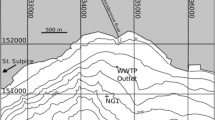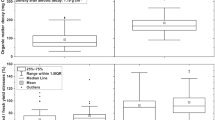Abstract
Hopper dredging operations release suspended sediment into the environment by agitation of the bed and by discharge of overflow slurries. Monitoring of turbidity and suspended sediment concentrations in central Chesapeake Bay revealed two plumes: (1) an upper plume produced by overflow discharge and (2) a near-bottom plume produced by draghead agitation and rapid settling from the upper plume. The upper plume dispersed over 5.7 km2 extending 5,200 meters form the discharge point. Redeposited sediment accumulated on channel flanks covering an area of 6.4 km2 and reached a thickness of 19 cm. Altogether dredging redistributed into the environment an estimated 100,000 tons of sediment or 12 percent of the total material removed.
Near-field concentrations of suspended sediment, less than 300 m from the dredge, reach 840 to 7,200 mg/L or 50 to 400 times the normal background level. Far-field concentrations (>300 m) are enriched 5 to 8 times background concentrations and persist 34 to 50 percent of the time during a dredging cycle (1.5 to 2.0 h). The overflow discharge plume evolves through three dispersion phases: (1) convective descent, (2) dynamic collapse, and (3) long-term passive diffusion (Clark and others 1971). The bulk of the material descends rapidly to the bottom during the convective descent phase, whereas the cloud that remains in suspension is dispersed partly by internal waves. Although suspended sediment concentrations in the water column exceed certain water quality standards, benthic communities survived the perturbation with little effect.
Similar content being viewed by others
References Cited
American Public Health Association, 1981, Standard methods: 134 p.
Biggs, R. B., 1968, Environmental effects of overboard spoil disposal: Journal of the Sanitary Engineering Div., v. 94 p. 477–487.
Brandsma, M. B., and D. J. Divoky, 1976, Development of models for prediction of short-term fate of dredged material discharged in the estuarine environment: U.S. Army Corps of Engineers, Waterways Experiment Station, Contract Rept. D-76-5, 133 p.
Burks, S. A., and R. M. Engler, 1978, Water quality impacts of aquatic dredged material disposal: U.S. Army Waterways Experiment Station Environmental Laboratory. Tech. Rept. DS-78-4.
Clark, B. D., W. F. Rittall, D. J. Baumgartner, and K. V. Byram, 1971, The barged ocean disposal of wastes, a review of current practice and methods of evaluation: Environmental Protection Agency, Pacific Northwest Water Laboratory. 120 p.
Cronin, L. E., R. B. Biggs, D. A. Flemer, G. T. Pfitzmeyer, F. Goodwin, Jr., W. L. Dovel, and D. E. Richie, Jr., 1970, Gross physical and biological effects of overboard spoil disposal in Upper Chesapeake Bay: Natural Resources Institute Special Report No. 3, Chesapeake Biological Laboratory, University of Maryland. 66 p.
Cronin, W. B., M. G. Gross, W. R. Taylor, R. C. Whaley, W. C. Boicourt, and J. R. Schubel, 1976, Investigations of dredging operations, Brewerton Channel cut-off angle, Patapsco River mouth disposal site, 10 April 1976–26 May 1976: Chesapeake Bay Institute, The Johns Hopkins University, Final report to the State of Maryland and the U.S. Army Corps of Engineers, Baltimore District. 50 p.
Diaz, RJ., and D. F. Boesch, 1977, Impact of fluid mud dredged material on benthic communities of the tidal James River, Virginia: U.S. Army Corps of Engineers, Waterways Experiment Station. Tech. Rept. D-78-21, 118 p.
Diaz, R. J., L. C. Schaffner, R. J. Byrne, and R. A. Gammisch, 1985, Baltimore Harbor and channels aquatic benthos investigations: Final Rept. to Baltimore Dist., U.S. Army Corps of Engineers, Baltimore, MD. 255 p.
Gross, M. G., W. R. Taylor, R. C. Whaley, E. O. Hartwig, and W. B. Cronin, 1976, Environmental effects of dredging and dredged material disposal, approaches to Chesapeake and Delaware Canal, northern Chesapeake Bay: Chesapeake Bay Institute unpublished report to Maryland Department of Natural Resources. 86 p.
Gross, M. G., and W. B. Cronin, 1979, Dredging and Disposal in Chesapeake Bay, 1975–2025.In H. D. Palmer, and M. G. Gross, eds., Ocean Dumping and Marine Pollution: Dowden, Hutchinson & Ross, Inc., Stroudsburg, Pennsylvania, p. 131–145.
Hampton Roads Maritime Association, 1985, The port of greater Hampton Roads, Annual, 1985. 259 p.
Harrison, W., M. P. Lynch, and A. G. Altschaefel, 1964, Sediments of Lower Chesapeake Bay with emphasis on mass properties. J. Sed. Petrol. v. 34, p. 727–755.
Johnson, B. H., 1974, Investigation of mathematical models for the physical fate prediction of dredged material: U.S. Army Engineer, Waterways Experiment Station, Tech. Rept. D-74-1.
Johnson, R. E., G. F. Oertel, and G. T. F. Wong, 1980, Water quality monitoring of the deepening of the Southern Branch of the Elizabeth River, Chesapeake, Virginia: Old Dominion University Tech. Rept. 42, 102 p.
Kuo, A. Y., C. S. Welch, and R. J. Lukens, 1985, Dredge induced turbidity plume model: Journal of Waterway, Port, Coastal and Ocean Engineering, v. 111, no. 3, p. 476–494.
Nichols, M., 1982, Metal inventory and fate of suspended sediment in Chesapeake Bay. VA Institute of Marine Science, Special Scientific Rept. 106, 97 p.
Nichols, M., 1983, What are the best guidelines for dredging and placement of dredged material?In Cronin, ed., Ten Critical Questions for Chesapeake Bay in Research and Related Matters: Chesapeake Research Consortium Pub. 113, p. 50–62.
Nichols, M., 1986, Man's physical effects on the Elizabeth River: A Case Study: Proc. Chesapeake Bay Research Conference, Williamsburg, VA, p. 166–178.
Nichols, M. R., R. Faas, and G. Thompson, 1978, Fluid mud dredged material: its physical nature and dispersal: U.S. Army Engineer, Waterways Experiment Station, Tech. Rept. D-78-40, 84 p.
Nichols, M., and R. Diaz, 1987, Plume monitoring of Rappahannock and York Spit channels, Baltimore Harbor and channels (Phase I): Contr. Rept. to the U.S. Army Corps of Engineers, Baltimore District. 39 p.
Nichols, M., and R. Diaz, 1989j, Plume monitoring of Rappahannock and York Spit channels, Baltimore Harbor and channels (Phase II). York Spit Channel: Contr. Rept. to the U.S. Army Corps of Engineers, Baltimore District, 33 p.
Okubo, A., 1962, A review of theoretical models for turbulent diffusion in the sea: Journal Oceanographical Soc. of Japan. 20th Anniversary volume, p. 286–320.
Peddicord, R. K., V. A. McFarland, D. P. Belfiori, and T. E. Byrd, 1975, Effects of Suspended Solids on San Francisco Bay Organisms: Report to U.S. Army Engineer District, San Francisco, Dredge Disposal Study, Appendix G.
Priest, W. I., 1981, A study of dredging effects in Hampton Roads, VA: Special Rept. in Applied Marine Science and Ocean Engineering No. 247, 266 p.
Raymond, G. L., 1984, Techniques to reduce the sediment resuspension caused by dredging: U.S. Army Engineer, Waterways Experiment Station, Miscell. Paper HL-84-3, 33 p.
Schaffner, L. C., R. J. Diaz, C. R. Olsen, and I. L. Larsen, 1987a, Faunal characteristics and sediment accumulation processes in the James River estuary, Virginia: Estuar. Coast. Shelf Sci., v. 25, p. 211–226.
Schaffner, L. C., R. J. Diaz, and R. J. Byrne, 1987b, Processes affecting recent estuarine stratigraphy.In Coastal Sediments 87, WW Div./American Society of Civil Engineers, New Orleans, LA, May 12–14, 1987, p. 584–599.
Schubel, J., and W. M. Wise, 1979, Questions about dredging and dredged material disposal in the Chesapeake Bay: Marine Sciences Research Center, State University of New York, Special Rept. 20, 143 p.
Sherk, J. A., J. M. O'Connor, D. A. Newmann, R. D. Prince, and K. V. Wood, 1974, Effects of Suspended and Deposited Sediments on Estuarine Organisms, Phase II: Final Report, U.S. Army Corps of Engineers Contract No. DACW72-71-C-ODO3. University of Maryland, Natural Resources Institute, Ref. No. 74-20.
State of Maryland, Water Resources Administration, 1976, Monitoring of Open Water dredged Material Disposal Operations at Kent Island Disposal Site and Survey of Ascociated Environmental Impacts: A report prepared for the Maryland Port Administration and the Maryland Department of Natural Resources. 119 p.
Stern, E. M., and W. B. Stickler, 1978, Effects of turbidity and suspended material in aquatic environments. Literature review: U.S. Army Corps of Engineers, Waterways Experiment Station. Tech. Rept. D-78-21. 118 p.
Sustar, J. F., T. H. Wakeman, and R. M. Ecker, 1976, Sediment-water interaction during dredging operations: Proc. Specialty Confr., Dredging and its Environmental Effects. Am. Soc. Civil Engr. p. 736–767.
U.S. Army Corps of Engineers, 1981, Baltimore Harbor and channels, Maryland and Virginia: Main Report and Environmental Statement, various pagination.
U.S. Environmental Protection Agency, 1983, Chesapeake Bay; a profile of environmental change. Washington D.C.
Virginia Institute of Marine Science, 1967, A study of the effects of dredging and dredge spoil disposal on the marine environment: Special Scientific Rept. in Applied Marine Science and Ocean Engineering, no. 8., 56 p.
Virginia Institute of Marine Science, 1972, Study of channel sediments Baltimore Harbor, Norfolk Harbor, York Entrance Channel: Contr. Rept. to the U.S. Army Corps of Engineers. 102 p.
Author information
Authors and Affiliations
Rights and permissions
About this article
Cite this article
Nichols, M., Diaz, R.J. & Schaffner, L.C. Effects of hopper dredging and sediment dispersion, chesapeake bay. Environ. Geol. Water Sci 15, 31–43 (1990). https://doi.org/10.1007/BF01704879
Issue Date:
DOI: https://doi.org/10.1007/BF01704879




